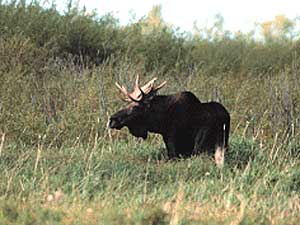|
Photos
|
February 10, 2005
 |
| A bull moose in a sedge grass meadow in late summer. (Photo courtesy of the U.S. Fish and Wildlife Service) |
Fergus Falls, Minn. — In the mid 1980s, wildlife managers started to notice moose in northwest Minnesota were dying in larger than usual numbers. They appeared to be diseased and starving despite abundant food supplies.
There were about 3,500 moose in 1993. By 2002, the population fell to about 400. In 1995, researchers began putting radio collars on moose and carefully examining the moose that had died. Data collection ended in 2000.
Warren Ballard, a professor at Texas Tech University, has been studying that data ever since. Ballard discovered two primary causes of death. Serious infestation by a parasite called the liver fluke, and deficiency in some important trace minerals.
"Both of these we call proximate factors," Ballard said at a recent conference in Fergus Falls. "That's the immediate cause of death. Ultimately it could be related to climate change. It's definitely gotten warmer in Minnesota in the last 40 years."
Moose eat mostly branches from trees like alder and willow. Ballard says warmer weather may have changed the trace minerals in the food source. He says that needs more research.
But Ballard says there's clear evidence moose don't do as well in warmer weather.
"Summer stress from high temperatures, basically overheating, can have a substantial impact on the condition of moose going in to the winter," said Ballard. "So in other words the warmer it gets in the summer they go in to the winter in poorer shape and are not as productive. "
Fewer moose being born, and rampant disease among the population doesn't bode well for the future.
That's disappointing for Gary Hauschle, a biologist at Agassiz National Wildlife Refuge near Thief River Falls.
"As the refuge managers, we're hoping to find the smoking gun that we could make a correction to, and this doesn't give us that," Hauschle said.
Wildlife managers could try to capture and treat sick moose. But Hauschle says that would be very expensive and might not reverse the population decline.
"So at this time, we will go on and try to keep providing habitat in the best quality we can and wait and see what weather and other factors will shake out in the future," Hauschle said. "And see whether the population will recover or maybe it will slowly fade away."
Some ecologists predict the Minnesota moose population is headed for extinction. Texas Tech researcher Warren Ballard won't go that far.
But he says the moose population in northwest Minnesota is now so small it's very vulnerable to catastrophic events like a very harsh winter.
"That could be enough to just tip that population over in a flash, and it would never recover," Ballard said. "That's what happens when you get down to low numbers. Things start getting a little dicey. If everything stays constant you're ok. But one major catastrophic non-predictable event could tip things."
No additional research is planned at the present time. Minnesota DNR and the Federal Fish and Wildlife service officials say there's little they can do but to wait for nature to take it's course.





